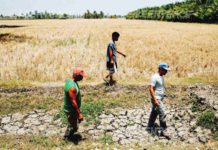ILOILO City – Though Western Visayas is not classified a “high risk” area for the reemergence of the highly infectious viral disease poliomyelitis, the Department of Health (DOH) will be strengthening its routine immunization program in the region.
While polio has no cure, it can be prevented through vaccination, stressed Dr. Renilyn Reyes, DOH Region 6 medical officer.
DOH confirmed on Thursday the re-emergence of polio in the country, 19 years after the World Health Organization (WHO) declared the Philippines polio-free in 2000.
Polio mainly affects young children. The virus is transmitted by person-to-person spread mainly through the fecal-oral route or, less frequently, by a common vehicle (such as contaminated water or food) and multiplies in the intestine, from where it can invade the nervous system and can cause paralysis.
“The oral polio vaccine (OPV) is freely administered to babies in health centers. Ang ini nga bakuna indi masakit kay ginapatulo lang sa baba sang bata,” said Reyes.
For the routine immunization, Reyes said, three primary doses of polio vaccine are given to babies.
“Ang DOH nagapasalig nga ang ini nga bakuna safe kag epektibo,” said Reyes.
The first dose is given when the baby is at least six weeks old; second dose when the baby at least 10 weeks old; and third dose when the baby at least 14 weeks old.
Initial symptoms of polio include fever, fatigue, headache, vomiting, stiffness in the neck, and pain in the limbs.
According to the DOH, one polio case was confirmed in a three-year-old girl from Lanao del Sur. Aside from the confirmed case, a suspected case of acute flaccid paralysis is awaiting confirmation.
Poliovirus was also detected in water samples from sewage in Manila and waterways in Davao as part of the regular environmental surveillance.
The samples were tested by the Research Institute for Tropical Medicine and verified by the Japan National Institute for Infectious Diseases and the United States Centers for the Disease Control and Prevention.
In 2018, DOH identified 12 out of the 17 regions in the country as high-risk areas for polio reemergence.
The National Capital Region is one of the identified regions with a high-risk of re-infection due to a number of factors including low polio vaccination coverage coupled with poor surveillance of polio symptoms, ongoing practice of open defecation, and poor sanitary practices in communities.
According to DOH, a single confirmed polio case of vaccine-derived polio virus type 2 (VDPV2) or two positive environmental samples that are genetically linked isolated in two different locations is already considered an epidemic in a polio-free country.
DOH, in close coordination with local government units and concerned national agencies, and with the support of WHO, the United Nations Children’s Fund and other partners, is preparing a rapid response to the polio outbreak.
This includes a series of synchronized oral polio vaccinations to protect every child under the age of five years in the areas at risk beginning October 2019.
DOH is also working with partners to strengthen environment and acute flaccid paralysis (the sudden onset of muscle weakness or paralysis of the upper and lower extremities) surveillance throughout the country to detect polio virus.
Health secretary Francisco Duque III remind the public to practice good personal hygiene, wash their hands regularly, use toilets, drink safe water, and cook food thoroughly./PN



